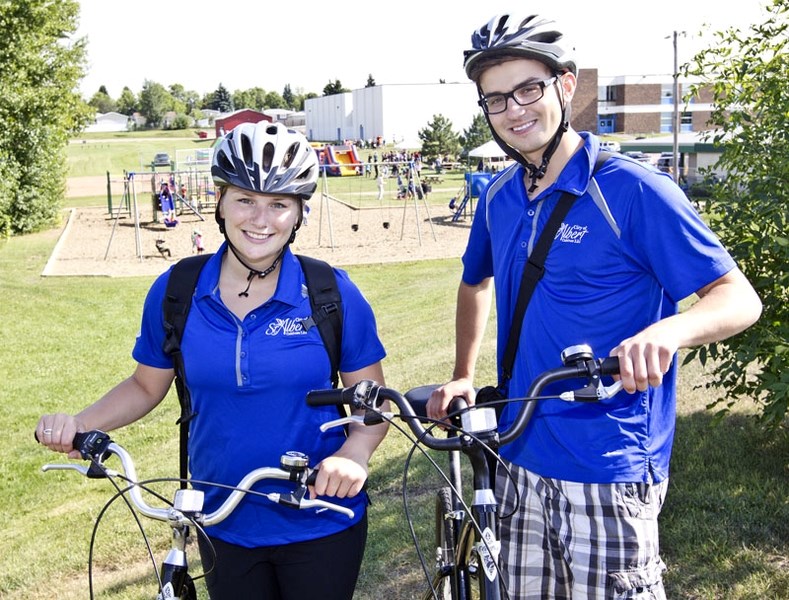A massive public engagement effort has been underway this summer as part of the first phase of a community visioning process.
The effort has included surveys on kiosks, postcards, a website and summer students touring the trails on bikes to engage with residents to gather input for what’s being called “Cultivating Our Future,” a visioning process led by the community sustainability committee.
“It allows us to hit all parts of the city,” said public engagement summer student Jeremy Jakubowski, who, along with fellow summer student Kaitlyn Fenton, has been hitting the trails on a bike to get public input into the process.
In addition to engaging people while out and about, Fenton and Jakubowski have been attending the farmers’ market, block parties and other community events.
“It’s been a lot of positive things, which has been awesome,” said Fenton.
The questions they’re asking are the same as the ones on the community mailout, asking residents what they like best about St. Albert today, what changes they’d like to see and what their vision is for the city for the next 50 years.
And while love of parks and trails in St. Albert is an obvious one when talking to people on the trails – and one the students have been hearing a lot about – they’ve heard about other topics as well.
“A lot of people are very supportive of downtown which is huge,” Fenton said.
Jakubowski said they hear a lot about the feelings of community and connection in St. Albert, reminding him of the small-town feel he experienced growing up in Parry Sound, Ont.
Kalen Pilkington, community sustainability co-ordinator for the city, said they try to get people to think about all the sustainability pillars like environment, social and economic issues.
“It’s been really surprising to me because I thought people would be so strong on environmental and nothing else, but it’s been really balanced within the community,” Pilkington said.
“A lot of the big themes, they really fit into these pillars of sustainability,” said Jakubowski. “From there we can move forward.”
Response so far has surpassed their expectations, with the students engaging about 1,400 people and about 2,100 people just after the August mid-point.
“It’s actually been overwhelmingly amazing,” Pilkington said. They set an initial goal of 800 people, upped it to 1,300 and now are aiming for 2,300.
“We’ve never really done a public engagement this large in the community so we really didn’t know what to expect for numbers,” Pilkington said.
Putting the students on bikes while wearing their St. Albert shirt has made it easier for people to approach them, Pilkington said.
They’ve developed a social media presence on Facebook, Twitter and Instagram, and are planning walking tours in partnership with the museum in September.
They have a self-facilitated toolkit so people could host mini-sessions at their home and send in the results, and Pilkington said if people want them to come to events or facilitate groups, they’d be happy to do that as well.
The second phase of the community visioning process will kick off in October, talking back a draft of the proposed vision to make sure it reflects the residential feedback given during phase one.
That will include some similar efforts to this summer’s work, but also have some more in-depth sessions like focus groups and workshops.
The final document will come out in 2015, Pilkington said.
Asked why a community visioning process is important, Pilkington said the last time a vision for the city was created was in 1999.
“A considerable amount has changed,” she said.
The vision will be embedded in the municipal development plan and future master plans, so the vision will be incorporated throughout the city, she said.
“The high level vision that ties everything together.”
The community sustainability visioning project was approved by council in 2013 for inclusion in the 2014-2016 budget with a price tag of $276,050. The funding for the visioning process is provided through federal gas tax funding which is granted to the city.
For more information:
www.stalbert.ca/stafuture




